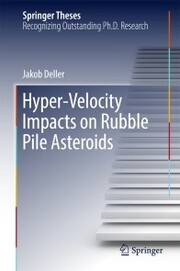Detailansicht
Hyper-Velocity Impacts on Rubble Pile Asteroids
eBook - Springer Theses
ISBN/EAN: 9783319479859
Umbreit-Nr.: 4159168
Sprache:
Englisch
Umfang: 0 S., 9.39 MB
Format in cm:
Einband:
Keine Angabe
Erschienen am 01.12.2016
Auflage: 1/2016
E-Book
Format: PDF
DRM: Digitales Wasserzeichen
- Zusatztext
- <div>The thesis presents a tool to create rubble pile asteroid simulants for use in numerical impact experiments, and provides evidence that the asteroid disruption threshold and the resultant fragment size distribution are sensitive to the distribution of internal voids. This thesis represents an important step towards a deeper understanding of fragmentation processes in the asteroid belt, and provides a tool to infer the interior structure of rubble pile asteroids.</div><div>&nbsp;</div><div>Most small asteroids are 'rubble piles' re-accumulated fragments of debris from earlier disruptive collisions. The study of fragmentation processes for rubble pile asteroids plays an essential part in understanding their collisional evolution. An important unanswered question is what is the distribution of void space inside rubble pile asteroids? As a result from this thesis, numerical impact experiments can now be used to link surface features to the internal structure and therefore help toanswer this question.</div><div>&nbsp;</div><div>Applying this model to asteroid ¦teins, which was imaged from close range by the Rosetta spacecraft, a large hill-like structure is shown to be most likely primordial, while a catena of pits can be interpreted as evidence for the existence of fracturing of pre-existing internal voids.</div><div>&nbsp;</div><div><br></div>
- Kurztext
- The thesis presents a tool to create rubble pile asteroid simulants for use in numerical impact experiments, and provides evidence that the asteroid disruption threshold and the resultant fragment size distribution are sensitive to the distribution of internal voids. This thesis represents an important step towards a deeper understanding of fragmentation processes in the asteroid belt, and provides a tool to infer the interior structure of rubble pile asteroids.&nbsp;Most small asteroids are 'rubble piles' - re-accumulated fragments of debris from earlier disruptive collisions. The study of fragmentation processes for rubble pile asteroids plays an essential part in understanding their collisional evolution. An important unanswered question is &quote;what is the distribution of void space inside rubble pile asteroids?&quote; As a result from this thesis, numerical impact experiments can now be used to link surface features to the internal structure and therefore help to answer this question.&nbsp;Applying this model to asteroid Steins, which was imaged from close range by the Rosetta spacecraft, a large hill-like structure is shown to be most likely primordial, while a catena of pits can be interpreted as evidence for the existence of fracturing of pre-existing internal voids.&nbsp;
- Autorenportrait
- <div>Jakob Deller has defended his PhD thesis in September 2015. His PhD project was jointly accompanied and funded by the University of Kent and the Max Planck Institute for Solar System Research, Göttingen. He was awarded the Pierazzo International Student Travel Award by the Planetary Science Institute, Tucson, Arizona, and presented his work in multiple international conferences. He gained observing experience at the NTT at La Silla Observatory, Chile.</div><div><br></div><div>He was awarded his M. Sc. in November 2011 with a thesis on the Stability of some recently found circumbinary systems supervised by Prof. Dr. S. Dreizler at the Institute for Astrophysics Göttingen, Germany. </div><div><br></div>
